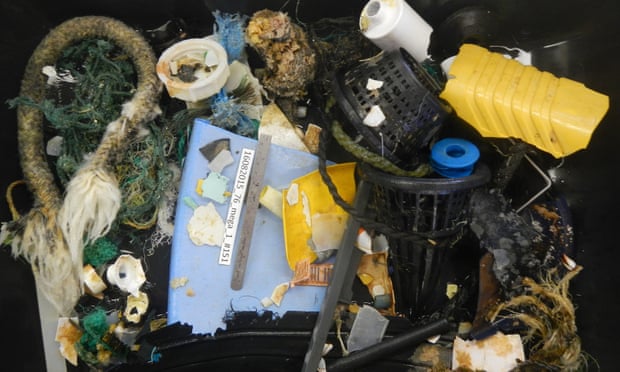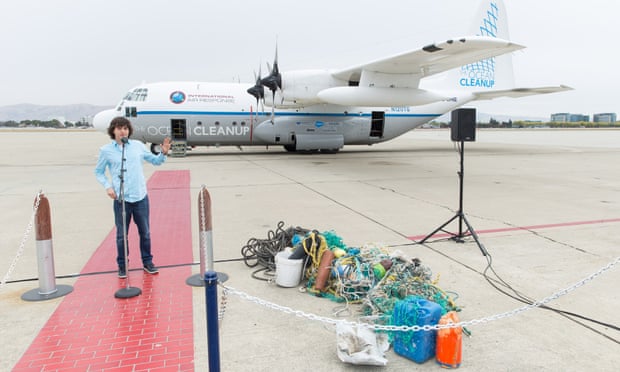"We opened the door and we saw the debris everywhere. Every half-second you see something." Photograph: Ocean Cleanup
From The Guardian by Oliver Milman
Giant collection of fishing nets, plastic containers and other discarded items called a ‘ticking time bomb’ as large items crumble into micro plastics
The vast patch of garbage floating in the Pacific Ocean is far worse than previously thought, with an aerial survey finding a much larger mass of fishing nets, plastic containers and other discarded items than imagined.
A reconnaissance flight taken in a modified C-130 Hercules aircraft found a vast clump of mainly plastic waste at the northern edge of what is known as the “great Pacific garbage patch”, located between Hawaii and California.
The density of rubbish was several times higher than the Ocean Cleanup, a foundation part-funded by the Dutch government to rid the oceans of plastics, expected to find even at the heart of the patch, where most of the waste is concentrated.
“Normally when you do an aerial survey of dolphins or whales, you make a sighting and record it,” said Boyan Slat, the founder of the Ocean Cleanup.
“That was the plan for this survey. But then we opened the door and we saw the debris everywhere. Every half second you see something. So we had to take snapshots – it was impossible to record everything. It was bizarre to see that much garbage in what should be pristine ocean.”
Boyan Slat, founder of the Ocean Cleanup : aerial expedition, Ocean Force One tour
Photograph: The Ocean Cleanup
The heart of the garbage patch is thought to be around 1m sq km (386,000 sq miles), with the periphery spanning a further 3.5m sq km (1,351,000 sq miles).
The dimensions of this morass of waste are continually morphing, caught in one of the ocean’s huge rotating currents.
The north Pacific gyre has accumulated a soup of plastic waste, including large items and smaller broken-down micro plastics that can be eaten by fish and enter the food chain.
According to the UN environmental programme, the great Pacific garbage patch is growing so fast that it, like the Great Wall of China, is becoming visible from space.
Last year, the Ocean Cleanup sent 30 vessels to cross the patch to scoop up micro plastics in fine nets to estimate the extent of the problem.
However, the new reconnaissance flights from California have found that large items of more than half a meter in size have been “heavily underestimated”.
Slat said: “Most of the debris was large stuff. It’s a ticking time bomb because the big stuff will crumble down to micro plastics over the next few decades if we don’t act.”
Following a further aerial survey through the heart of the patch on Sunday, the Ocean Cleanup aims to tackle the problem through a gigantic V-shaped boom, which would use sea currents to funnel floating rubbish into a cone.
A prototype of the vulcanized rubber barrier will be tested next year, with a full-sized 100km (62-mile) barrier deployed by 2020 if trials go well.
The boom will not be able to suck up all of the strewn rubbish, however, with Slat warning that plastic is “quite persistent. We need to clean it up, but we also need to prevent so much entering the oceans. Better recycling, better product design and some legislation is all part of that. We need a combination of things.”
Using about 30 vessels, The Ocean Cleanup currently executes the largest ocean research expedition in history, aiming to determine how many tons of plastic are in the Great Pacific Garbage Patch.
The full scale of plastic pollution was revealed in 2014, when a study found there were more than 5tn pieces of plastic floating in our oceans.
In 2014, 311m tonnes of plastic were produced around the world, a 20-fold increase since 1964.
It is expected to quadruple again by mid-century.
A report by the Ellen MacArthur Foundation earlier this year predicted there would be more plastic than fish in the oceans by 2050 unless urgent action was taken.
Links :
- Huffington Post : The Great Pacific Garbage Patch Is Even Worse Than We Feared
- The Telegraph : 'Great Pacific Garbage Patch' is a myth, warn experts, as survey shows there is no 'rubbish island'
- Christian Science Monitor :Great Pacific Garbage Patch is denser than previously thought
- Science Alert : The Great Pacific Garbage Patch contains even more trash than we thought
- GeoGarage blog :Ocean Cleanup Project's trash-catching prototype takes ... /How to clean up the Oceans while making alternative fuels / Full scale of plastic in the world's oceans revealed for first ... / Ocean garbage patch is mysteriously disappearing / Trashed / The Ocean Cleanup : it could work / Garbage-eating drone destroys ocean pollution / Big rise in North Pacific plastic waste


No comments:
Post a Comment